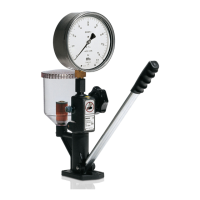1 689 979 467 2012-10-10| Robert Bosch GmbH
24 | EPS 100 | Testen
5.6 Spray shape
i The test instructions and test values for nozzle
holder assemblies in ESI[tronic] are binding for
Bosch products.
Testing the spray shape:
1. Close shutoff valve.
! High pressure peaks can damage the pressure gauge.
2. Push down hand-operated lever evenly, so that the
spray shape can be tested during spraying.
Additional information and criteria:
¶ 2-spring holders with seat hole-type nozzle cannot
be checked.
¶ With hole-type nozzles, all spray holes should be well
sprayed.
¶ Nozzles that spray limp or at an angle are not sound
and must not be used.
¶ DN..SD. . Spray shapes differ due to the structural
design of the nozzles. The spray shape must be even
¶ DN.. SD.. Surface pintle-type nozzles have a lateral
microsection on the spray tappets, which creates a
particular spray shape.
¶ The cross-section of the spray from a surface pintle-
type nozzle is oval and larger than the spray from a
reducing pintle type nozzle without a surface on the
spray tappet.
¶ Wear on the seat area will impair the chatter
behavior of a nozzle.
¶ During testing, a used nozzle must audibly chatter
and/or spray efficiently when the lever is moved
quickly.
¶ The spray pattern may differ from the ideal
spray pattern of a new nozzle without the engine
performance being notably impaired.
¶ Appropriate cleaning measures (e. g. ultrasonic
cleaner) can visibly improve the spray pattern of a
used nozzle.
5.7 Chatter behavior
i Information on the chatter behavior, chatter
indicator groups, spray pattern and spray test is
available in ESI[tronic] in the test instructions for
nozzle and holder assemblies. The chatter indicator
groups apply for new nozzles only.
Chatter behavior test:
1. Switch on pressure gauge.
! High pressure peaks can damage the pressure gauge.
2. Move the hand-operated lever slowly at first, until a
chatter sound is heard.
"The chatter indicates that the nozzle needle is not
restricted in its movement, i.e. nozzle seat and guide
are mechanically sound.
i If the nozzle does not chatter, the pump movement
speed must be increased.
! New nozzles that chatter when the pump is not
moving (slow through to abrupt and fast), are
unusable and must be replaced.

